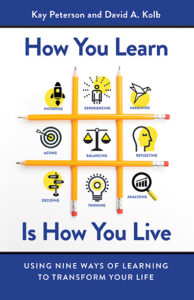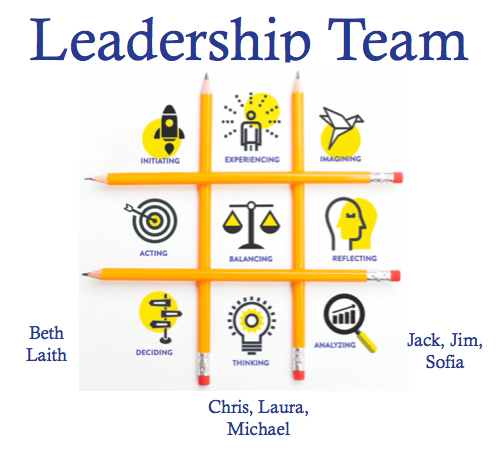How You Learn
Some people collect things. When I was growing up, I watched my father collect degrees. He was always taking a class, learning a new skill, or listening to an educational program. In fact, way beyond retirement and the age when most of us would consider it, he’s finishing up a doctorate in yet another field.
I learned early on: one of the secrets to happiness and success is to become a lifelong learner.
Kay Peterson and David Kolb delve into how you can renew and enhance your natural ability to learn. How You Learn Is How You Live will inspire your learning journey.
I recently asked Kay to share more about her research into learning styles and lifelong learning.
Understand Learning Styles
What is a learning style?
A learning style is a way of navigating the ideal process of learning- the learning cycle- that emphasizes some parts over others. It’s not a fixed trait. Learning style preferences can change to meet life situations.
How and when do we develop our primary learning style?
Culture, personality, education, career choice and the demands of life influence learning style. Your preferences start early; yet they are not fixed traits. An active child may prefer to be outside exploring rather than sitting in a classroom. If she finds success through actively experimenting, it will lead to greater skill in these areas and a greater desire to use this style. The child may practice the Acting style until it becomes a habitual way of approaching any situation. Your learning style and life path are based on the choices you make.
Is there an assessment to identify what ours is?
The assessment that measures learning styles is the Kolb Learning Styles Inventory 4.0. It defines 9 different learning styles and reports learning flexibility, the ability to use the other 8 styles as “back up” styles to meet different situations.
What practical benefits have you noticed once someone fully understands their primary style?
Five outcomes that allow people to benefit from understanding learning style:
- Raise self-awareness about your strengths and link your preferences to your life choices
- Recognize why your performance may not be as strong as it could be in certain situations and offer strategies for improvement
- Interpret communication differences that occur when someone you know is “coming from a different place”
- Strengthen and balance relationships within organizations, teams and families by discovering how one’s strengths cover another’s weaknesses and vice versa.
- Broaden choice in any situation by deliberately recognizing, while there is a preference, there is also an array of other learning styles available to improve effectiveness
Do you constantly find yourself trying to identify people’s styles even in non-coaching situations (like a server at a restaurant, etc.)? What are some of the key indicators or phrases that signal a style?
Understanding people through their learning style makes them even more interesting to me. I am constantly intrigued by the notion that we try to choose situations that allow us to be successful; so it’s very evident when a server at a restaurant would rather be Reflecting than Acting!
I am especially alert to learning styles when I try to connect with others. Language, content and even movements can reveal one’s learning style. For instance, someone who prefers the Acting style communicates dynamically and rapidly in a commanding tone. She might mention time, results, achieving an outcome, moving off center: “Who does what by when?” “Time is money.” Typically, she even moves quickly and purposefully. Having a checklist for interactions with her would make for better contact with her than if I meandered in conversation, not making my points clear.
A person with a preference for the Reflecting style—the style opposite to Acting—may be deliberate, patient, and sensitive to the feelings of others as she tries to make sense of a situation before rushing to action. She may prefer watching instead of doing, and may be silent for periods in order to process the situation and speak thoughtfully: “Let me explore this idea.” “Can I get back to you?” Typically, she is calm, unhurried in her movements or even still. As I approach her, I’ll be more successful if I allow her time to process rather than urgently demanding a decision.
Opposite Styles
Are there opposite styles where one style finds it very difficult to work with the other? What strategies can help in these situations?
Yes, people who have different style preferences may find it difficult to work together and communicate because learning styles show up in the most basic ways. This seems especially prominent in opposite styles. Style preferences run so deep that, often, it doesn’t dawn on people they are irritating others through their behavior. For instance, one who prefers the Experiencing style may prefer face-to-face meetings instead of email or phone calls. It may never dawn on him that others who prefer Deciding, Thinking or Analyzing styles may find this inefficient, unnecessary, or even painful. By contrast, one who prefers the Thinking style can see problems everywhere. He searches for what is wrong and offers critical feedback. It may never dawn on him to notice what is right or to offer praise, the type of approach one with an Experiencing style would prefer.
Pausing to become aware of another’s learning style can prevent an unproductive automatic response. When people make their learning styles explicit and discuss events and situations in terms of learning style preferences, they are able to increase understanding of their intent and impact. One can also practice meeting others where they are, adjusting a habitual response to meet what is important to another. For instance, one with an Imagining preference who values generating new ideas may recognize the need to dampen her natural tendency when speaking with someone who prefers the Deciding style and values focused and practical problem solving.
Talk a little about how you can build style flexibility.
People can learn to build flexibility by developing capabilities associated with the new styles in several ways. Simple awareness of the array of learning styles may be enough to build flexibility in non-dominant styles.
Another flexibility-building strategy is to stop overusing one’s preferred style, allowing other styles to emerge. If someone with a Reflecting style preference dampens her typical measured approach and need for perfection, she may find that she does not hold back from trying something new (Acting) and recovers from mistakes (Initiating).
It can be most difficult to develop the style opposite from one’s preference. The more one is deeply attached to his preferred style, the more he sees the opposite style as negative. In order to get unstuck, he must recognize that he values his own style so much that he over-tolerates its downside, too. Someone who favors the Acting style so strongly values results that she may not recognize sometimes she’s simply being busy and not productive. And, by seeing only the downside of the opposite Reflecting style—perfectionism and procrastination–she misses out on its upside—aiming toward the right goal. By focusing on the upside of Reflecting, she is able to endure the learning curve to build flexibility in her choice of style.
The learning cycle process provides the map for learning a new style. Try something new, pay attention to the experience and feelings, reflect on what went well and what could be improved; then, step back to compare the performance to the standard. Practicing over and over again allows people to find their own unique way to express the styles that seem unfamiliar.
Are there certain careers where you find styles clustered? For instance, most in academia are _______ or most doctors are _______, etc.?
 Many professionals in academia are drawn to teaching and research with the Thinking, Analyzing or Reflecting styles. Early research shows that teachers teach the way they learn. These styles support the lecture and test model most people knew in school.
Many professionals in academia are drawn to teaching and research with the Thinking, Analyzing or Reflecting styles. Early research shows that teachers teach the way they learn. These styles support the lecture and test model most people knew in school.
Many people in professions that require science and math competence, such as engineering, medicine and technology, tend to prefer the styles associated with Abstract Thinking: Analyzing, Thinking and Deciding. These styles support the scientific problem-solving mentality that allows them to be successful. However, these individuals are most at risk of “entrenchment” and find it difficult to build flexibility in the feeling-oriented learning styles of Initiating, Experiencing and Imagining. When they rise to positions of leadership and need to expand their skills to include influencing others, building relationships, and demonstrating empathy, they may fall short.
How Leadership Teams Are Impacted by Styles
How have you seen leadership teams impacted by these styles?
In my current research, I’m interviewing leaders through a lens of learning styles. Early results indicate that how we learn is how we lead, too. The leader who prefers the Acting style is strong at achieving results on time. The leader with a preference for Analyzing creates airtight plans based on data. The leader who prefers Experiencing relies on the power of trusting relationships.
I find that the research holds true in practice: Teams comprised of diverse learning styles (deep diversity) are highly effective, especially when they make learning styles explicit. When leadership team members appreciate each other’s strengths and challenges and understand the learning cycle as a map for teamwork, they are able to take over leadership at different steps in the process. The leader with the Imagining style can direct the diverging, idea generation phase of identifying possible outcomes and setting a vision. The leader with a strong Analyzing style can take the primary role to synthesize the information that allows the team to create a plan. The leader who prefers the Initiating style can influence the team to seize opportunities.
Leadership teams that share similar styles may see the world similarly and agree easily; yet they can find themselves coming up short over the long run. One leadership team comprised of professionals who preferred only Analyzing, Thinking and Deciding style preferences focused solely on solving problems and reproducing predictable results. They suffered from not tapping into the strengths of the Experiencing style (relationships), Imagining (vision and creativity), and Initiating (seizing new opportunities). Over time, this leadership team found that their business suffered.
Would you share an example of “overuse” of one of the styles?
All the learning styles have an upside and a downside. By overusing a style, people ultimately experience the downside. Strength becomes a weakness. One who overuses the Imagining style may never make the decisions to allow her to complete a project. One who overuses the Deciding style—opposite to Imagining on the cycle—may judge too early, never allowing for novelty or diversity. An HR Director who preferred the Initiating style was so over-focused on starting new training and development programs that he didn’t provide time for his staff to plan and implement existing programs well or measure their impact.
For more information, see How You Learn Is How You Live.


